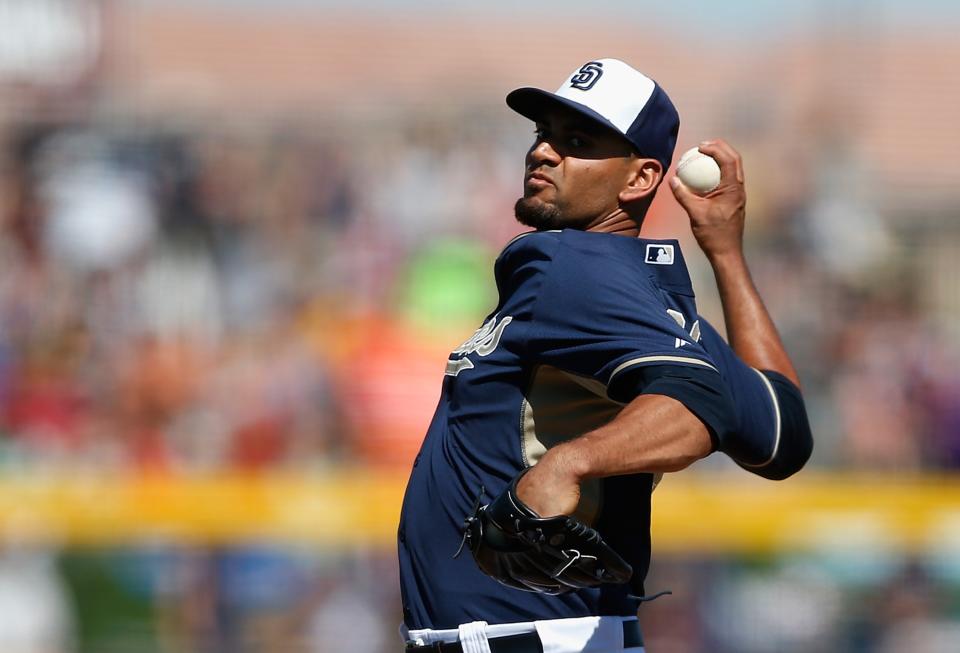Fantasy Baseball Position Primer: Starting Pitcher
Whatever statistical lines of demarcation you've used in the past to define good, bad and ordinary pitching performances, it's well past time for an update. We've hammered away at this general theme in earlier Position Primers, you might have noticed. The run-scoring environment has changed substantially in recent seasons, so fantasy managers need to adapt.
[Yahoo Sports Fantasy Baseball: Sign up and join a league today!]
Back in 2004, for example, the Atlanta Braves led all major league teams in ERA at 3.74. Last year, the average MLB pitching staff posted a 3.74 ERA. Seventeen teams finished below that number, and the average National League ERA was 3.66.
Among all individual pitchers who tossed more than 140.0 innings in '04, only 19 posted ERAs below 3.50. Last season, 26 pitchers delivered sub-3.00 ERAs with over 140 frames of work, and 48 hurlers were below 3.50.
So yeah, times have changed. The strike-zone is clearly expanding while hitters are quite possibly shrinking. Thus, many of the statistical plateaus that seemed significant a decade ago are now completely uninteresting.
As Michael Salfino mentioned in his latest Pitching By the Numbers, "the most powerful pitching stat is some variation of strikeouts and walks." And this isn't some crackpot Salfino-ish take, either; it's actually a widely accepted principle. If you're looking for a shorthand method to identify the game's most effective arms, focus on defense-independent outs and defense-independent base-runners allowed. It's a fairly simple, sensible idea.
Over time, we've settled on the notion that any pitcher with a K-to-BB ratio of 3.0 or better merits serious attention in fantasy leagues. It's an imperfect standard, certainly, because ... well, because of guys like Joe Blanton and Ricky Nolasco. But still, it's been a useful guide over the years. These days, however, a whole big mess of starters are finishing with K/BB ratios north of 3.0. Here's a quick look at the total number of pitchers each year who've topped that mark since 2000 (minimum 140.0 IP):
2014 – 51
2013 – 44
2012 – 38
2011 – 39
2010 – 26
2009 – 26
2008 – 24
2007 – 21
2006 – 20
2005 – 30
2004 – 17
2003 – 20
2002 – 14
2001 – 17
2000 – 13
That's silly, right?
Again, the previous standard of excellence no longer seems as impressive. Last year, 112 major league pitchers threw at least 140.0 innings, and 51 of them produced K-to-BB ratios above 3.0. A dozen pitchers finished above 5.0 (including 2015 draft value Brandon McCarthy), with another 10 topping 4.0. Phil Hughes led MLB with a ridiculous 11.63 K/BB. (Hughes' current Yahoo average draft position is a similarly ridiculous 146.3, suggesting that many of you were forever scarred by the NYY years.)
Revise your old targets, friends. This will serve as your final warning. Just as you shouldn't bring a 2004 preview magazine to a 2015 draft — you'd leave the room with Esteban Loaiza and both Giles brothers — you can't bring old performance standards to today's game.
---
Position averages for the top-48 starting pitchers, last three years
SP1 — 16.6 W, 220.7 K, 2.52 ERA, 1.03 WHIP
SP2 — 12.3 W, 176.3 K, 2.81 ERA, 1.09 WHIP
SP3 — 12.4 W, 162.2 K, 3.06 ERA, 1.16 WHIP
SP4 — 12.8 W, 140.0 K, 3.31 ERA, 1.20 WHIP
2013, SP1 — 14.5 W, 211.8 K, 2.70 ERA, 1.02 WHIP
2013, SP2 — 13.1 W, 163.0 K, 2.95 ERA, 1.14 WHIP
2013, SP3 — 12.0 W, 164.9 K, 3.31 ERA, 1.18 WHIP
2013, SP4 — 11.8 W, 154.0 K, 3.47 ERA, 1.21 WHIP
2012, SP1 — 17.2 W, 189.8 K, 2.73 ERA, 1.07 WHIP
2012, SP2 — 13.6 W, 190.1 K, 3.30 ERA, 1.15 WHIP
2012, SP3 — 13.7 W, 162.8 K, 3.45 ERA, 1.23 WHIP
2012, SP4 — 11.7 W, 133.3 K, 3.60 ERA, 1.20 WHIP
Note: We’re treating the starters as four positions, with “SP1” representing the 12 highest-ranked players. The pitchers ranked 13-24 are SP2s, pitchers 25-36 are SP3s, etc.
[Want to join a league and live draft right now? Go to the Yahoo Draft Lobby]
STARTING PITCHER TIERS
TIER ONE
Clayton Kershaw
Felix Hernandez
Max Scherzer
TIER TWO
Stephen Strasburg
Madison Bumgarner
Chris Sale
David Price
Corey Kluber
Zack Greinke
TIER THREE
Cole Hamels
Jordan Zimmermann
Jon Lester
Johnny Cueto
Adam Wainwright
Matt Harvey
Alex Cobb
Julio Teheran
Hisashi Iwakuma
Gerrit Cole
Jake Arrieta
James Shields
Alex Wood
Jeff Samardzija
Sonny Gray
Tyson Ross
Jacob deGrom
Phil Hughes
Gio Gonzalez

TIER FOUR
Carlos Carrasco
Anibal Sanchez
Hyun-Jin Ryu
Garrett Richards
Andrew Cashner
Masahiro Tanaka
Chris Archer
Mat Latos
Doug Fister
Lance Lynn
Yordano Ventura
Ian Kennedy
Michael Wacha
Homer Bailey
Collin McHugh
Justin Verlander
TIER FIVE
Mike Fiers
Drew Smyly
Francisco Liriano
Jered Weaver
Jose Quintana
Jose Fernandez
Jake Odorizzi
Scott Kazmir
Brandon McCarthy
Matt Shoemaker
Ervin Santana
Kyle Lohse
Matt Cain
John Lackey
Michael Pineda
James Paxton
Danny Salazar
Shelby Miller
TIER SIX
Rick Porcello
Jenrry Mejia
Drew Hutchison
Wily Peralta
RA Dickey
Tanner Roark
Matt Garza
Dallas Keuchel
AJ Burnett
Chris Tillman
Jesse Hahn
Jason Hammel
Derek Holland
Henderson Alvarez
Danny Duffy
Mike Minor
Yusmeiro Petit
Kevin Gausman
Mike Leake
Carlos Martinez
Taijuan Walker
CC Sabathia
Trevor Bauer
Jonathon Niese
Wei-Yin Chen
Andrew Heaney
Nathan Eovaldi
Anthony Cingrani
Yovani Gallardo
Tim Hudson
Clay Buchholz
Bartolo Colon
Dan Haren
Noah Syndergaard
Archie Bradley


